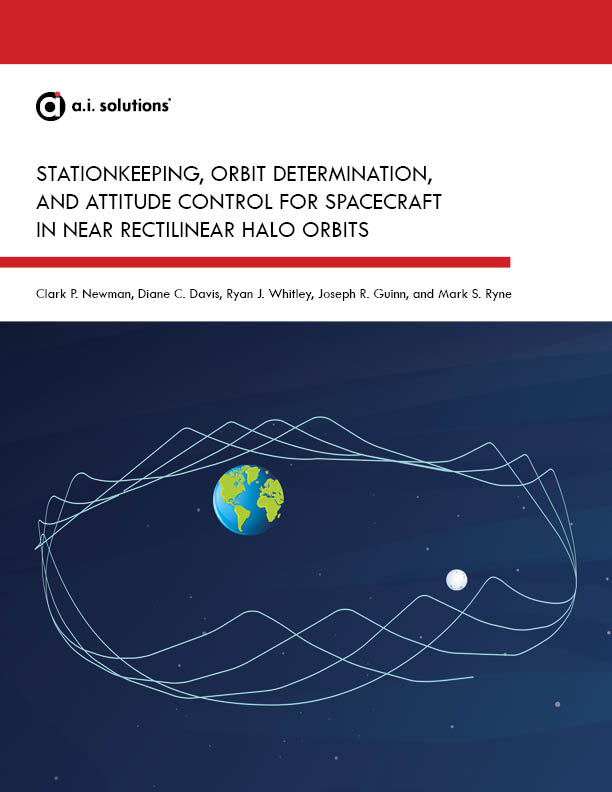
Automated
How can NRHOs be used to stabilize spacecraft?
From a Near Rectilinear Halo Orbit (NRHO), NASA’s Gateway at the Moon is planned to serve as a proving ground and a staging location for human missions beyond Earth. Stationkeeping, Orbit Determination (OD), and attitude control are examined for uncrewed and crewed Gateway configurations. Orbit maintenance costs are investigated using finite maneuvers, considering skipped maneuvers and perturbations. OD analysis assesses DSN tracking and identifies OD challenges associated with the NRHO and crewed operations. The Gateway attitude profile is simulated to determine an effective equilibrium attitude. Attitude control propellant use and sizing of the required passive attitude control system are assessed.
Introduction
NASA’s proposed Gateway near the Moon is planned as part of an evolutionary staging into deep space crewed missions. The Gateway is designed as a proving ground for deep space technologies and a staging ground to facilitate missions to low lunar orbit and the lunar surface as well as to asteroids and Mars. The Gateway is envisioned as a crew-tended spacecraft that will operate in both crewed and un-crewed environments, built up in stages over time. Gateway components may arrive as co-manifested pay-loads with the Orion spacecraft or they may be launched individually.
To support Gateway goals, a cislunar Near Rectilinear Halo Orbit (NRHO)1 is currently baselined at the Gateway trajectory. The four NRHO families are subsets of the larger halo families and are characterized by bounded stability properties. The baseline NRHO is an L2 southern halo in a 9:2 resonance with the lunar synodic period. The orbit passes through perilune over the north lunar pole approximately every 6.5 days with a close approach radius of about 3,200 km and an apolune radius of approximately 70,000 km. While the target NRHO exhibits nearly stable characteristics, an uncontrolled spacecraft in the NRHO will eventually depart the vicinity of the Moon. Small orbit maintenance maneuvers (OMMs) are required to ensure long-term operations in the NRHO, and the cost of the OMM depends on the quality of the navigation solution available. Solar pressure and the gravity gradient near perilune affect the spacecraft attitude, and moments can be significant, especially on long Gateway stacks. An appropriately sized attitude control system is needed to maintain spacecraft attitude.
In previous studies,1-4 the process of orbit maintenance (OM) of a spacecraft in an NRHO is investigated using impulsive maneuvers. The current investigation extends the x-axis crossing control method detailed previously to incorporate low-thrust maneuvers using solar electric propulsion (SEP) for configurations in which long, efficient maneuvers are preferable. Both uncrewed, quiet configurations and crewed, noisy configurations are explored. Docking and undocking perturbations are considered, and the effects of skipping maneuvers during both crewed and uncrewed operations are examined. Significant operational differences between the crewed and uncrewed cases lead to higher costs for stationkeeping during crewed operations.
The cost of orbit maintenance depends heavily on the quality of the orbit determination (OD) available for the Gateway. Gateway OD in the NRHO is explored via linear covariance analysis for ground-based, Deep Space Network (DSN) tracking for both uncrewed and crewed operations. Tracking data schedules are explored in both cases to determine thenumberofDSN passes required to meet OD requirements. Careful pass placement can help mitigate the effects of added perturbations during crewed operations.
Finally, an attitude control system (ACS) is considered. Attitude control must account for torques due to solar radiation pressure (SRP) and gravity gradient torques near the Moon. It must maintain a solar pressure equilibrium attitude (SPEA) during uncrewed operations and meet tail-to-Sun requirements of the Orion spacecraft during crewed operations. The ACS must also perform slews to orient the Gateway for OMMs.The ACS is defined as a control system paired with an angular momentum capacity to emulate reaction wheels or control moment gyros (CMGs) absorbing momentum to maintain a stable attitude. The control system is executed with either reaction control system (RCS)thrusters on the Power and Propulsion Element (PPE) of the Gateway or with control torques delivered by reaction wheels or CMGs. The design space is explored to determine attitude control performance, namely to document the use of RCShydrazinepropellant, and to assess feasible reaction wheel or CMG sizing to handle operations.
Click the image below to download the white paper.



